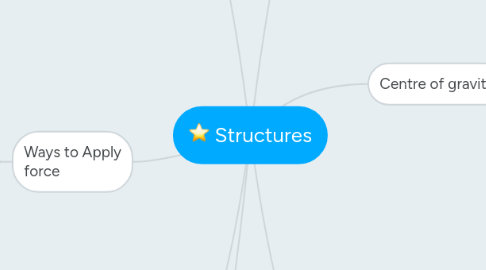
1. Structures
1.1. Shell
1.1.1. Shell structures are hollow and often used as container since there is space inside.
1.1.1.1. An example would be an igloo, since igloos are structures meant to contain living people and have a hollow inside.
1.1.1.2. An egg, it is hollow but contains a yolk or an animal.
1.2. Solid
1.2.1. Solid structures are structures that are solid all the way through (with exceptions such as caves).
1.2.1.1. For example, concrete since it is solid and isn't hollow.
1.2.1.2. A pillar, since it is solid to be stronger.
1.3. Frame
1.3.1. Frame structures are structures that are made of parts fastened together. Frame structures can have a coating (such as cars do).
1.3.1.1. A skeleton is a frame structure. What makes it a frame structure is the fact that bones are joint together as children grow.
1.3.1.2. A spider web, although the web is the structure alone and does not have coating.
1.4. Combination
1.4.1. A combination structure is a structure made of combining shell, frame, and solid structures.
1.4.1.1. For example, a house, because the house has a frame. They are shell because they must have space inside and they're solid because they use solid materials to build. (bricks, nails, etc.)
1.4.1.2. A car, since it has a frame, made of solid material and has to be built to contain people and objects (hollow).
2. Loads
2.1. Static Load
2.1.1. A static load is the effect of gravity on a structure.
2.1.1.1. Live Load
2.1.1.1.1. The effect of gravity but varies.
2.1.1.2. Dead Load
2.1.1.2.1. The dead load is the effect of gravity on the object/structure itself. Its weight does not change.
2.2. Dynamic Load
2.2.1. A dynamic load is a force that moves or changes while acting on the structure/object, the force changes magnitude, direction, or plane/point of application.
2.2.1.1. The wind blowing on a small tree. The strength of the wind can vary.
2.2.1.2. The river current on a dam. It can be strong but also gentle.
3. Ways to Apply force
3.1. Magnitude
3.1.1. Strength of which the force is applied
3.1.1.1. As an example for magnitude can be rivers. River currents can have a strong magnitude and a weak magnitude.
3.1.1.2. The wind can very its magnitude throughout the day. On a windy day a tree could be blown over since the magnitude could be strong.
3.2. Direction of Force
3.2.1. The direction of which the force is applied.
3.2.1.1. A person kicking a soccer ball forward towards a net.
3.2.1.2. Bumping a volleyball forward over the net.
3.3. Point of application
3.3.1. The exact point of an object that force is being applied to.
3.3.1.1. A person kicking a soccer ball directly in the middle of its side.
3.3.1.2. Hitting the volleyball directly on its bottom.
3.4. Plane of application
3.4.1. The side of an object that force is being applied to.
3.4.1.1. The side of a soccer ball that was kicked.
3.4.1.2. The bottom side of a volleyball that was bumped.
4. Centre of gravity
4.1. The centre of gravity is the heaviest point on an object or structure.
4.1.1. An example could be a person. The centre of gravity on a person can change. When they are standing up straight the centre of gravity is in their torso. However, when they spread their feet and bend their legs, their centre of gravity shifts downward.
4.1.2. On a balancing bird, the center of gravity is its beak since it is the point where it is perfectly balanced.
5. Force
5.1. Internal Force
5.1.1. Compression
5.1.1.1. A force that squeezes or presses something together.
5.1.1.1.1. For example, pushing down on someone's head, they feel compression in their neck.
5.1.1.1.2. Pushing down on a spring towards the surface and having it pop back up.
5.1.2. Tension
5.1.2.1. A force stretches something apart to expand.
5.1.2.1.1. An example could be play-dough, when you stretch it apart it begins to lengthen.
5.1.2.1.2. A rope being pulled in two different directions by two teams of people. Tension begins to take affect on the rope and it stretches slightly.
5.1.3. Torison
5.1.3.1. A force that twists something.
5.1.3.1.1. For example, twisting clay. Torsion affects the clay and causes it to change its form.
5.1.3.1.2. Wringing a socking towel dry. Torsion affects as the towel begins to twist when you wring it.
5.1.4. Shear
5.1.4.1. A force that pushes in opposite directions.
5.1.4.1.1. For example, touching your toes. You feel shear as your spine bends.
5.1.4.1.2. Pulling scissor blades apart from each other.
5.2. External Force
5.2.1. An external force impacts the object from the outside.
5.2.1.1. Gravity
5.2.1.1.1. Gravity is a force that pulls an object towards the equator.
6. Form
6.1. Form is the basic shape of a structure. The form of the structure can change depending on the function of the structure.
6.1.1. An example could be chair. The function of the chair is for people to sit on it, so the form would have a platform.
6.1.2. A glove is for people to wear it on their hand so it must have five finger holes for peoples hands.
7. Function
7.1. Function is the purpose of a structure/object and can determine the form.
7.1.1. An example could be a desk. The function of a desk is to contain and hold weight, have a flat surface to write on, and that determines the form.
7.1.2. Glasses must have a frame and glass so that people who wear them can see clearer.

